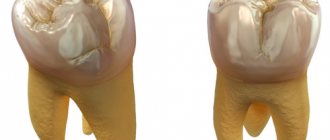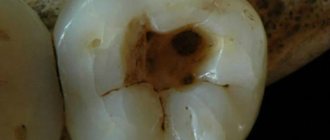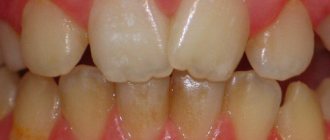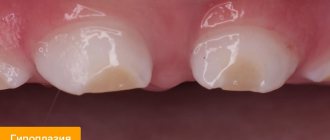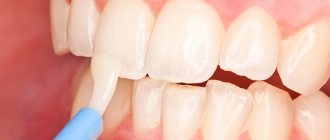Selective tooth grinding is a complex treatment method that is used for periodontal diseases. The procedure is used to correct occlusion and articulation on natural and artificial teeth, and allows you to evenly distribute the chewing load on the teeth. This is one of the most common methods in the complex therapy of periodontal diseases, which is used both in the initial and active stages of the pathological process.
Indications
Selective tooth grinding is a complex procedure that requires a strictly individual approach to each patient. In some cases, achieving an ideal ratio is impossible due to the structure of the jaw and individual teeth. In this case, the procedure is carried out in order to get as close as possible to the desired result.
The main purpose of grinding is to create uniform contact throughout the entire dentition, remove excessive load on the jaw and distribute it evenly over all teeth. To do this, hard tissues are ground off from the teeth that come into contact during chewing movements, after which they are aligned with the dentition, on which there are no points of contact.
Main indications for the procedure:
- improper closure of molars;
- increased tone of the masticatory muscles;
- displacement or deformation of the dentition due to injury;
- lack of natural tooth wear;
- abnormalities in the structure of the jaw;
- prevention of periodontal diseases.
In some cases, the grinding method is used to grind down sharp edges of teeth, which injure the tongue and oral mucosa. This saves the patient from minor injuries or damage.
Selective grinding of 1st tooth
Periodontitis is an inflammatory and destructive disease of the complex of tissues that surround the tooth and ensure its fixation in the jaw. According to WHO (2007), periodontal diseases occupy the first place among all dental diseases in middle-aged and elderly people. They affect more than 98% of the population. People over the age of 40 have up to 80% of their teeth removed due to periodontal disease. The quality of life of patients who have lost teeth is significantly reduced. Loss of teeth leads to dysfunction of chewing and digestion, causes psychological trauma, leads to pronounced aesthetic changes, diseases of the temporomandibular joint and gastrointestinal tract arise and worsen.
The main goal of preventing periodontal diseases is to prevent the formation or reduce the amount of existing bacterial plaque, microorganisms of which play the role of a trigger in the occurrence of periodontal pathology.
The vast majority of people are not fully informed about oral hygiene products and methods and do not even know that many of them exist. Therefore, dentists are obliged to systematically inform patients that:
- Improper hygiene causes the accumulation of harmful microorganisms and their metabolic products in the oral cavity;
- Local disturbance of the trophism of periodontal tissues, microbes and their toxins cause disruption of microcirculation in the periodontium, changes in the condition of the capillaries and the entire peripheral circulatory system;
- Supra- and subgingival dental deposits aggravate inflammation of marginal periodontal tissues;
- Disruption of the buffer balance in the oral cavity, a shift in pH from neutral alkaline to acidic as a result of the activity of dental plaque microorganisms contributes to the development of diseases;
- Changes in the properties and composition of saliva, an increase in its viscosity contribute to the formation of dental plaque and stones;
- Untreated teeth and foci of odontogenic infection are dangerous for the periodontium;
- Eating disorders and smoking as risk factors predispose to periodontal disease;
- Defects in prosthetics, overhanging edges of fillings and other local traumatic factors must be eliminated in a timely manner;
- Occlusal trauma leads to overload of individual sections of the dental arch, which is expressed in overload of the periodontium and redistribution of stress in it;
- The absence of antagonist teeth, including partial adentia, also determines the redistribution of loads and stresses in the periodontium, which leads to the formation of traumatic nodes in it;
- Malocclusion also plays an important role in changing the normal dental and biomechanical status of the oral cavity, which inevitably affects the condition of periodontal tissues.
It is extremely important to emphasize that the listed factors are unfavorable for the periodontium, and inflammatory periodontal diseases negatively affect the condition of the body as a whole.
Diagnostics:
During the diagnosis of periodontal diseases, the following parameters are assessed:
- determination of the hygienic state of the oral cavity,
- determination of gum bleeding during probing,
- determining the intensity and extent of the inflammatory response,
- measurement of the depth of periodontal pockets (PC) and loss of periodontal attachment,
- determination of tooth mobility,
- identification of supracontacts,
- determination of PC exudate,
- loss of dentogingival attachment,
- degree of destruction of bone tissue.
The severity of the lesion is determined based on the clinical and radiological picture.
Treatment:
One of the main principles of treatment of inflammatory periodontal diseases is an individual approach to the selection and planning of therapeutic procedures, taking into account the characteristics of the clinical manifestation of the disease in a particular patient, the presence of background pathology, possibilities and strict indications for prescribing drug treatment.
The main goals of periodontal treatment are;
- Elimination of inflammation in periodontal tissues,
- Elimination of periodontal pockets as a source and reservoir of microflora,
- Stopping bleeding from the gums and reducing tooth mobility,
- Stopping the destruction of bone and soft periodontal tissues,
- Establishing optimal occlusal relationships,
- Restoration of destroyed periodontal tissues and the physiological contour of the gums,
- Elimination of relapse of the disease and premature loss of teeth.
Complex treatment involves not only planning, but also the mandatory provision of all necessary types of care (etiological, surgical, orthopedic, local, general treatment). At the same time, it is important to correctly determine the sequence of necessary measures to eliminate the disease and correctly make a prognosis for each tooth.
When treating periodontitis, it is unsafe and ineffective to limit ourselves to removing dental plaque only. It is necessary to carry out comprehensive treatment of periodontal tissue diseases with the development of an individual oral hygiene plan and the appointment of periods of return visits for maintenance therapy.
Maintenance therapy involves periodic assessment of periodontal structures for timely prevention and treatment of newly emerging or previously existing periodontal lesions.
Mucogingival operations are interventions aimed at eliminating structural disorders of the soft tissues of the vestibule of the oral cavity, which not only aggravate the course of the inflammatory process in the periodontium, but in some cases are themselves the causes of its specific lesions.
Frenulotomy
Frenulotomy - plastic surgery of the frenulum. Indicated for thin, short frenulums of the lip and tongue. Frenulotomy of a thin, short frenulum is performed on newborns when it limits the movement of the tongue and interferes with feeding the child. In older children, this operation is performed for speech therapy, orthodontic indications, in case of injury to the marginal periodontium during movement of the lower lip. You can check the condition of the frenulum and its effect on the gums by performing a “tension” test. To do this, grab your lip with your fingers and pull it up and forward. Movement of the interdental papilla and pallor of the gums indicate periodontal trauma (positive “tension” syndrome).
Vestibuloplasty
Vestibuloplasty is a plastic deepening of the vestibule of the oral cavity. This type of surgical intervention is indicated for small vestibule of the oral cavity (less than 7-8 mm), complete absence or insufficiently wide (less than 2 mm) attached gum.
At a certain stage in the development of periodontal diseases, functional overload of the supporting apparatus and traumatic articulation occur, which cannot be eliminated either by therapeutic or surgical methods. In such cases, only orthopedic treatment, splinting and grinding can ensure success in the overall complex of therapy for these diseases.
Selective grinding of teeth
Selective grinding of teeth is necessary for periodontal diseases in the following cases:
- The presence of malocclusions and secondary deformations,
- Uneven wear of hard dental tissues,
- Lack of physiological abrasion of the tubercles.
Splinting teeth
As a result of grinding and splinting of mobile teeth, premature contacts are eliminated, which normalizes occlusal and articulatory relationships and thereby improves the condition of the periodontium. The goals of selective teeth grinding and splinting are as follows:
- Elimination of the traumatic situation in the periodontium by distributing the functional load over as many teeth as possible;
- Removing trauma to hard dental tissues and pulp;
- Load distribution along the axis of the teeth;
- Removing the pathological activity of the masticatory muscles;
- Elimination of balancing and hyperbalancing supercontacts;
- Prevention and treatment of periodontal pathology, masticatory muscles and the temporomandibular joint (TMJ) during the period of primary, mixed and permanent dentition.
Indications for occlusal grinding of teeth are:
- Increased tone of the chewing muscles (bruxism);
- Temporomandibular joint dysfunction;
- Fan-shaped extension of the incisors of the upper and lower jaws;
- Pronounced mobility of individual teeth;
- Exposure of the necks and roots of individual teeth due to uneven resorption of the bone tissue of the sockets.
The general goal of preventing dental diseases is to improve and strengthen the dental health of the population, increasing the number of citizens with a healthy dental system. Only timely and regular dental care can significantly reduce the risk of developing periodontal diseases and exacerbation of systemic diseases.
Contraindications
Sanding is not carried out in the following cases:
- During the period of progressive periodontal inflammation. In this case, before the main procedure, the patient is prescribed a course of treatment.
- The patient has been diagnosed with dental anomalies and deformations that require treatment by other specialists (orthopedist or surgeon).
- Acute and chronic diseases of the temporomandibular joint are observed.
The grinding procedure should only be carried out by a qualified specialist. Incorrectly performed correction can lead to displacement of teeth, excessive load on the periodontium due to flattening of the dental tubercle, and removal of one or more teeth from occlusal contact.
How does the procedure work?
The operation is carried out in several stages, with short breaks.
Preparation for the procedure is based on a preliminary visual examination of the patient. Closing the dentition helps to identify points of contact between the dental surface and the arch where this closure is absent. Next, final (more accurate) testing is done using carbon paper to identify all problem areas for further occlusion correction.
Based on the data obtained, zones for grinding are selected. The procedure itself may seem unpleasant, so it is usually carried out under the influence of an anesthetic. A preliminary test for allergic reactions eliminates all negative consequences from the use of painkillers.
The grinding procedure is carried out in three stages:
- At the first stage, a preliminary grinding procedure is carried out in order to eliminate the most pronounced unevenness of the dental surfaces. In case of significant shortening of teeth, mandatory depulpation is carried out.
- Next, the procedure is carried out on other teeth that require correction.
- After final polishing, fluoride-containing polishing pastes are used.
After each stage, treatment is carried out with special preparations that reduce tooth sensitivity.
Duration of treatment
Correcting crowding at the level of teeth and dentition takes from six months to two years, depending on the complexity of the clinical case. It is better to normalize the position and size of the jaws from childhood - with proper treatment, this will take no more than six months. In adults, it will not be possible to correct bone curvatures only with the help of orthodontic treatment - you will have to seek help from surgeons.
Interesting fact!
Typically, orthodontic treatment is performed on both jaws; in rare cases with slight crowding, treatment can be performed on one jaw.
Possible complications
If the rules for the procedure are not followed, the following complications are possible:
- decrease in interalveolar height;
- tooth displacement;
- hyperesthesia of hard tissues;
- excessive load on the periodontium after flattening the cusps of the teeth;
- removal of some teeth from occlusal contact and overload of the periodontium of others.
Therefore, the procedure can only be trusted to a dentist who has undergone special training and has the appropriate qualifications.
